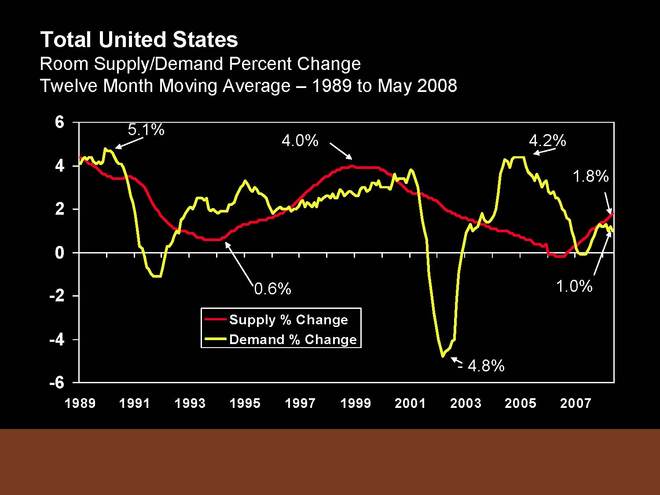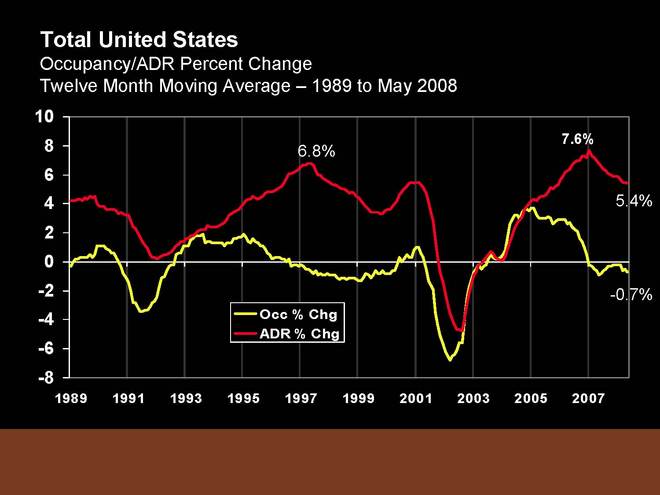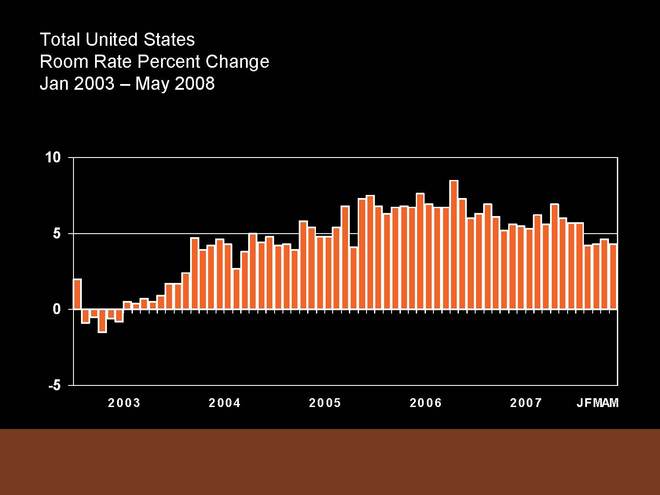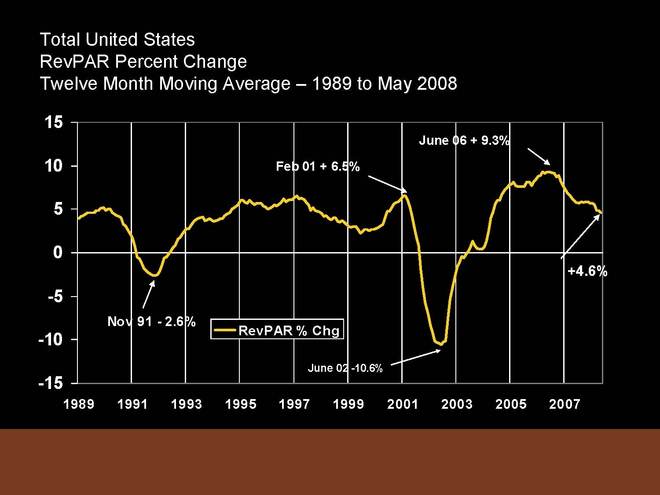Author of www.HotelLawBlog.com
10 June 2008
Hospitality lawyer with pearls from the New York hospitality conference. The mood in New York was more somber in June 2008 than it has been for a long time at hotel conferences. Final attendance was about 2400 (about the same as last year) and for the first time, NYU had fewer conference delegates than the Los Angeles conference in January (3,200 at ALIS in January 2008). Many believe that attendance at these conferences is a good barometer of sentiment in the industry — send more people when times are good, and send fewer when you batten down the hatches for a storm.
I had the opportunity to listen to Randy Smith and Mark Lomanno of Smith Travel Research in two sessions this past week — one private session at the Lodging Industry’s think tank (the Lodging Industry Investment Council or LIIC) and in the general opening session at NYU. My commentary includes selected slides from STR, and a link to the full STR presentation can be found at the end of the article. Here is a Hospitality Attorney’s executive summary.
PEARLS OF WISDOM
There were just too many pearls of wisdom gathered in New York for one blog. So to make them more digestible, we have broken them into segments as follows:
State of the U.S. Lodging Industry
What’s Weekday vs. Weekend demand tell us?
Whither Lodging Demand, GDP and the Cost of Gasoline?
Top Quips, Quotes and Insights from the 2008 NYU hotel conference
All these segments will be posted shortly, so check back if you don’t see the one you want.
It was only a few months ago that hotel industry pundits speculated that we were only in the 3rd or 4th inning of the good times for the hotel industry’s surge in growth and profits. Now, at least a few revel in predicting looming bankruptcies, receiverships and workouts.
Hotel Lawyer summary of the Smith Travel Research data presented at NYU Hotel Conference
• The real rate and RevPAR growth excitement today is “international”
• The hospitality industry is going to be “fine” in the near term, slowing down to overall RevPAR growth of 3% for 2008 and 2.8% for 2009, and going up from there (the 2008 and 2009 numbers are not far under the 20-year average of 3.4% growth)• The results will be better than these averages for the “Growth Scales” (luxury, upper upscale, upscale and midscale without F&B), and worse for the “Mature Scales” (midscale with F&B and economy)
• There is still a very high correlation between changes in U.S. GDP and demand for hotel rooms (as measured by room nights sold)
• New supply is diminishing, and there is less cause for concern today about new supply than there was a year ago. This bodes well for profits as a recovery picks up in late 2009 or 2010
• The damaging practice of “discounting” to maintain market share (and its downward spiral) has NOT emerged. There is no indication that discounting is a successful strategy to maintain or improve profits
• Airline capacity and lift will have an impact on the industry, but Lomanno notes that airline prices were much higher in the 1970s and 1980s and Smith says that if airline prices go up, people will still drive or take the train
Please note that I have inserted selected slides from the STR presentation below, and the full STR slideshow is available with the link at the very end of this article.
Word to the wise: Don’t over-react. It is going to be OK.
Last week, all Randy Smith and Mark Lomanno could do when they heard dire predictions was to shake their heads. Randy said wryly, “In the hotel industry, we always think that whatever is happening now, will keep happening forever. If things are going well, we think it will last forever. And if things are slowing down, we think that will last forever, too.”
Mark Lomanno says the gloom and doom is way overdone and inappropriate. “We seem to over-react to most developments in the hotel industry, and if that is what people are saying, then, here we go again,” he said.
After a private roundtable session with the Smith Travel executives, viewing their full slide show at NYU, and studying the slides they were kind enough to share, here is my take on this:
FUNDAMENTALS OF U.S. SUPPLY, DEMAND AND REVPAR
Here are the slides on U.S, supply, demand, occupancy, ADR, RevPAR, and key statistics. While the data show a softening of fundamentals, Randy and Mark both emphasized that the numbers are NOT terrible, they are just not as great as they have been for the past few years.
In the first slide, on supply and demand, Randy asked us all to look at the yellow line which shows occupancy. In the last two downturns, as the yellow line starts to dive in 1990 and again in 2001, you can see that the hotel industry was just coming off very high supply growth numbers represented by the red line. But this time things are very different. The supply growth had been falling since 1999 or 2000 through some time in 2006, and only then started up gently to the projected 1.8% supply growth we have been experiencing.
Randy says that we are an industry that has always planted the seeds of our own demise with big supply growth leading to oversupply. The last 5-6 years of below historic-norm supply growth is a very positive sign for the industry, and STR believes that the supply growth line will head down from here. Supply growth was actually worse a year ago than it is today.
Supply and Demand — 1989-2008
Although occupancy growth has flattened, rates have maintained themselves pretty well, and there is no steep fall off in occupancy or rate comparable to past declines in 1990 and 2001. At some level, yield management is working.
You can see that there has been some fall off in ADR growth over the past few months, but that was inevitable. The high rate growth was never going to remain at those levels.
Randy and Mark were both very clear that they do not believe that lowering room rate generates demand, and they hope the industry learned its lesson and avoids predatory and nonproductive price cutting to maintain occupancy.
Occupancy/ADR Change — 1989-2008
ADR — Room Rate Change
RevPAR Percent Change — 1989-2008
Key performance indicators 2006 – 2008P
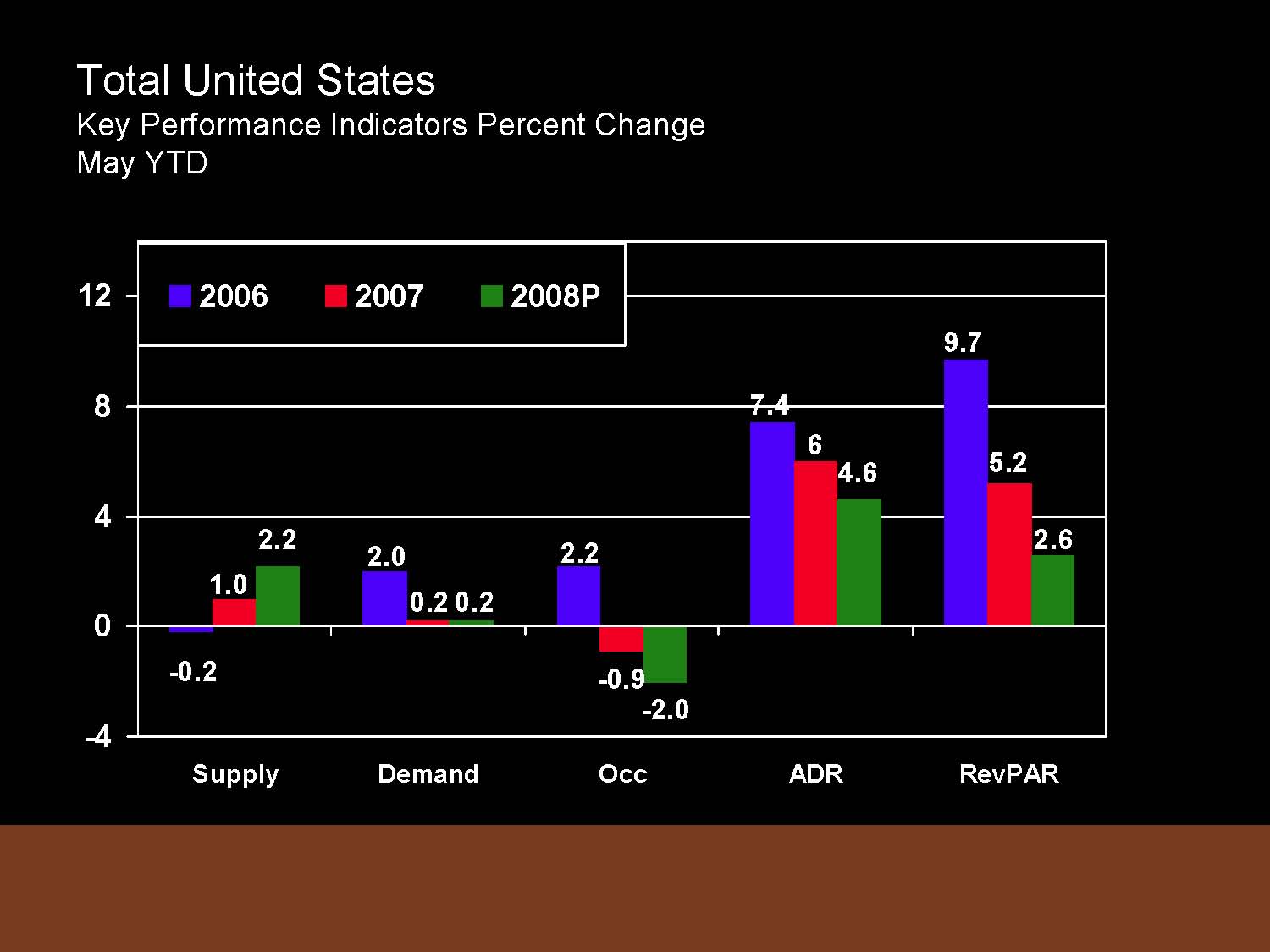
Link to STR’s full slide show at NYU Hotel Investment Conference 2008.
My take on the data is above. Here is the link to the full unadorned slide show as presented by Randy Smith of Smith Travel Research on June 2, 2008. STR 2008 Data.
This is Jim Butler, author of www.HotelLawBlog.com and hotel lawyer, signing off. We’ve done more than $87 billion of hotel transactions and more than 100 hotel mixed-used deals in the last 5 years alone. Who’s your hotel lawyer?
________________________
Our Perspective. We represent developers, owners and lenders. We have helped our clients as business and legal advisors on more than $125 billion of hotel transactions, involving more than 4,700 properties all over the world. For more information, please contact Jim Butler at jbutler@jmbm.com or 310.201.3526.
Jim Butler is one of the top hospitality attorneys in the world. GOOGLE “hotel lawyer” or “hotel mixed-use” or “condo hotel lawyer” and you will see why.
Jim devotes 100% of his practice to hospitality, representing hotel owners, developers and lenders. Jim leads JMBM’s Global Hospitality Group® — a team of 50 seasoned professionals with more than $87 billion of hotel transactional experience, involving more than 3,900 properties located around the globe. In the last 5 years alone, Jim and his team have assisted clients with more than 100 hotel mixed-use projects — frequently integrated with energizing lifestyle elements.
Jim and his team are more than “just” great hotel lawyers. They are also hospitality consultants and business advisors. They are deal makers. They can help find the right operator or capital provider. They know who to call and how to reach them.
Jim is frequently quoted as an expert on hotel issues by national and industry publications such as The New York Times, The Wall Street Journal, Los Angeles Times, Forbes, BusinessWeek, and Hotel Business. He is the Conference Chairman of The Hotel Developers Conference™ and Meet the Money®.
Contact him at jbutler@jmbm.com or 310.201.3526. For his views on current industry issues, visit www.HotelLawBlog.com.




